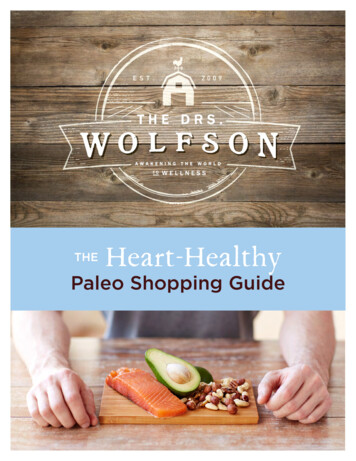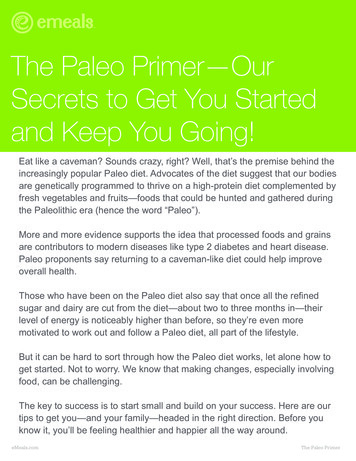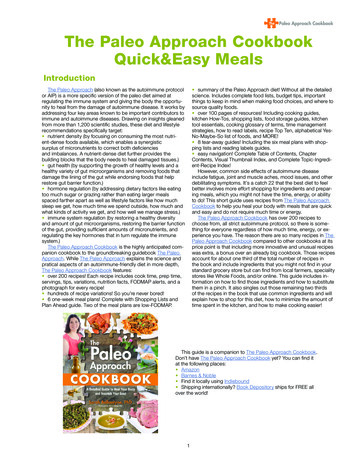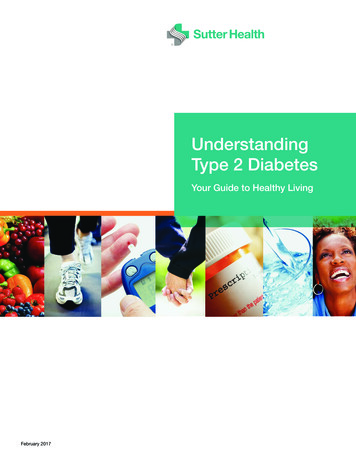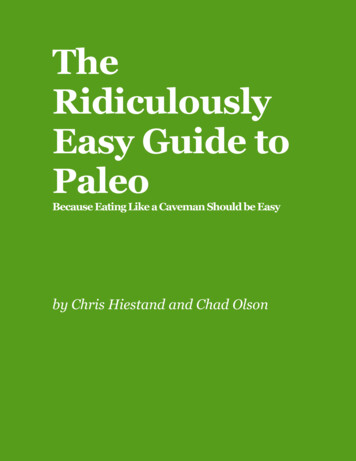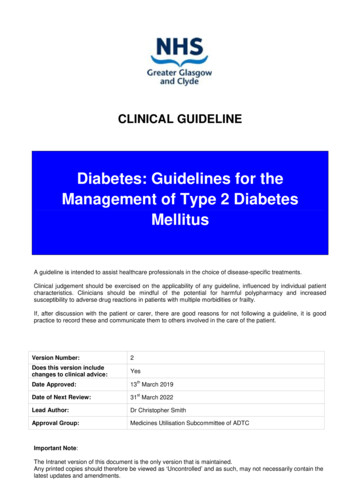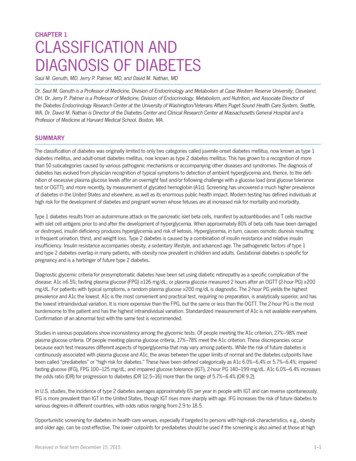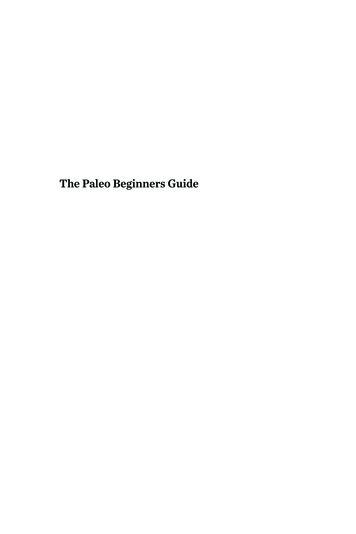
Transcription
The Paleo Beginners Guide
The PaleoBeginners GuideA SPECIAL EDITION OF THE NEW YORK TIMESBEST SELLER PALEO FOR EVERY DAYPresented byDr. Ryan Lazarus
No part of this publication may be reproduced, stored in a retrieval system, or transmitted in any formor by any means, electronic, mechanical, photocopying, recording, scanning, or otherwise, except aspermitted under Section 107 or 108 of the 1976 United States Copyright Act, without the prior writtenpermission of the publisher.Limit of Liability/Disclaimer of Warranty: The publisher and the author make no representations or warranties with respect to the accuracy or completeness of the contents of this work and specifically disclaimall warranties, including without limitation warranties of fitness for a particular purpose. No warrantymay be created or extended by sales or promotional materials. The advice and strategies contained hereinmay not be suitable for every situation. This work is sold with the understanding that the publisher is notengaged in rendering medical, legal, or other professional advice or services. If professional assistance isrequired, the services of a competent professional person should be sought. Neither the publisher nor theauthor shall be liable for damages arising herefrom. The fact that an individual, organization, or websiteis referred to in this work as a citation and/or potential source of further information does not mean thatthe author or the publisher endorses the information the individual, organization, or website may provideor recommendations they/it may make. Further, readers should be aware that Internet websites listed inthis work may have changed or disappeared between when this work was written and when it is read.
ContentsIntroduction 1PART ONEGetting StartedChapter One: Paleo Diet Basics 5Chapter Two: How to Use the Paleo Diet Meal Plan 25PART TWOPutting the Paleo Diet Meal Plan into ActionChapter Three: Week One 39Chapter Four: Week Two 47Chapter Five: Week Three 55PART THREEPaleo Diet RecipesChapter Six: Breakfast 65Chapter Seven: Lunch 89Chapter Eight: Dinner 107Chapter Nine: Dessert 137Chapter Ten: Pantry Recipes 155Appendix: Paleo Snacks 167Resources 169
IntroductionThe Paleo Beginners Guide was created to detoxify your body, burnfat, and build lean muscle. Following this plan, you’ll transform yourbody, boost your nutritional intake, and improve your overall health.More specifically, this meal plan balances your hormones for effective andsustainable weight loss. It helps stabilize your brain chemistry for increasedclarity of thought. It improves endocrine health and metabolic functionality,and promotes digestive health and more complete nutrient absorption. It evenhelps reduce and manage stress. And it helps you sleep more soundly.After just a few days of eating a Paleo diet, it will be clear why so manypeople follow the Paleo way of eating and living. In this book, you’ll find a simpleto-follow twenty-one-day meal program with easy recipes for breakfast,lunch, dinner, dessert, and quick snacks. Each week starts off with a detailedshopping list to help you save both time and money. Daily tips, cooking terms,guidelines, and other motivators will help you stay on the Paleo plan and besuccessful with it.The Paleo lifestyle delivers noticeable results without leaving you feelingstarved or deprived. The Paleo Beginners Guide is the plan to get you started onthe way to a new, improved you.1
PA R T ON EGetting StartedC H A P T E R O N E PALEO D IE T BAS IC SC H A P T E R T WO H OW TO U S E TH E PALE O D I ET MEA L PLA N
C HA P TER ONEPaleo Diet BasicsPaleo is a way of life. The name and concept of the Paleo lifestyle is based onthe idea of eating what our human ancestors subsisted on during the Paleolithicera. Our ancestors were hunters and gatherers who ate only what they couldharvest, fish, hunt, or scavenge. Paleo followers believe that our bodies weredesigned to eat as these early people did, and doing so will enable us to remainhealthy, muscular, and fit.Paleo nutritionists and many other scientists believe that evolution hasnot caught up with the advances of our society. By consuming the foods thatsustained our ancestors (such as pastured meats, sustainable seafood, freshvegetables, wild fruit, and foraged nuts) rather than those produced by modern agricultural and commercial processing methods (such as grains, legumes,dairy, sugars, and artificial additives), we can maximize nutrition absorption and burn foods more efficiently. In the long run, experts believe, eatingthe Paleo way will stave off harmful diseases and improve overall health andwell-being.Unlike other high-protein, low-carb diets, eating the Paleo way focuseson feeding your body the best-quality, most sustainably produced, least processed foods possible. When it comes to carbohydrates, the Paleo lifestyleencourages consuming only low-glycemic carbs from fresh vegetables alongwith fruits that are low in sugar to stabilize and maintain insulin levels. Quality protein from wild-caught seafood and pastured meat and eggs—rather thanfrom commercially produced or processed proteins—repairs and builds muscle. And eating omega-3 fatty acids found in grass-fed meat, seafood, and nutsand seeds promotes better heart and brain health.While the Paleo lifestyle encourages you to prepare more of your meals athome, you also have many options when dining out. But once you start usingThe Paleo Beginners Guide’s shopping, cooking, and food storage tips, you’ll seehow easy this “cleaner,” healthier way of eating can be. And how much betteryou look and feel.5
PALEO LIFESTYLE GUIDELINESAs we’ve pointed out, the Paleo lifestyle focuses on consuming nutritious vegetables and fruits along with quality proteins and fats. To make the most of thePaleo plan, it’s important to avoid refined sugars, dairy, grains, and processedfoods with added sodium, preservatives, and other unnatural ingredients.Here’s a quick look at some of the foods you will enjoy on the Paleo diet: Healthful oils and fatsHormone- and antibiotic-free meat (preferably from pasture-raised,grass-fed animals)Most fruits, with an emphasis on berriesMost vegetablesNuts and seedsSustainably sourced fish and shellfishHere are the main groups of foods you will avoid when eating Paleo: Added saltDairyGrains and legumesHydrogenated and other processed oils (sunflower, canola)Partially hydrogenated oils (margarine, alternative butter spreads)Processed foodsRefined and artificial sugarsThe Paleo lifestyle does not involve calorie counting. Instead, you eatPaleo-approved foods when you’re hungry and stop when you’re satisfied. Themeal plans show you how to balance every meal and snack with lean proteins,healthful fats, and vegetables and/or fruits. Still, this isn’t a license to go crazy.Stick to the recommended portion sizes. If you’re still hungry, incorporate anadditional Paleo-friendly snack to your day or increase your vegetable and protein portions.WHY FOLLOW THE PALEO DIET?Current nutritional research links diseases like type 2 diabetes, heart diseases, autoimmune disorders, and even some cancers with eating too many6 The Paleo Beginners Guide
processed foods, sugars, saturated fats, and refined carbohydrates—the unfortunate staples of the modern American diet.Avoiding the disease-causing foods and eating the Paleo diet has many benefits: Clearer skin and healthier hair, nails, and teethFat loss and improved muscle toneImproved digestion and reduced allergies and food sensitivitiesIncreased energyMore efficient workoutsReduced inflammation throughout the bodyReduced risk of long-term diseases, such as heart disease, hypertension,and diabetesStabilized blood sugarAnti-inflammation. Repeated studies have shown that refined and processedfoods, grains, and dairy can increase inflammation in the body that may causethe immune system to mistake healthy cells for disease-causing pathogensand attack them. Some believe there is a strong link between chronic bodilyinflammation and many forms of cancers and autoimmune diseases. ThePaleo way of eating focuses on avoiding foods that may cause inflammationand instead eating antioxidant-rich vegetables and fruits that promote healthycell production, swallow up cancer-causing free radicals, and boost our bodies’ illness-fighting capabilities. Fruits and vegetables are also slightly alkaline,which means they help reduce acidity in the body, another known culprit forcertain diseases and energy deprivation.Heart health. Paleo encourages the consumption of omega-3 fatty acids,which are shown to lower bad cholesterol levels and boost the good, improveblood chemistry, and boost brain health. Some studies suggest that we ingesttoo many omega-6 fats, commonly found in processed foods and refined oils,and that this may contribute to chronic inflammation, impeding the absorption of heart-healthy nutrients. Even some olive oils, which are thought to behealthful, are overly processed and stripped of their nutritional properties. Ifwe raise the level of omega-3 fatty acids in our bodies by eating more foodsrich in omega-3s and limiting omega-6 fats, we can improve the health of ourhearts and minds.Paleo Diet Basics 7
Recent clinical studies have shown that high-protein diets are more effective in improving cholesterol than low-fat, high-carbohydrate diets. This isbecause the body burns proteins and fats more efficiently than it does sugarsand excess carbohydrates, which convert to and are stored as fat when notburned off, leading to weight gain as well as increased “bad” cholesterol levelsand potentially heart disease in the long run.Improved digestion. Some refined and processed foods like gluten and dairyhave been linked to poor digestion issues and in some cases, may even causedamage to the intestinal lining. This damage can allow undigested foods and toxins to flow back into the bloodstream and cause “leaky gut” syndrome, which canlead to food sensitivities and allergies, chronic inflammation, and other longterm health problems. The Paleo diet removes processed and refined foods fromthe menu, helping you avoid or recover from these problems.Hormone stabilization. Eating Paleo has been shown to improve hormonelevels in the body. When hormone levels are out of balance, they can impedeweight loss and lead to other problems, like excess body fat, low energy levels,high stress, and problems with blood sugar. For example, when cortisol, alsoknown as the “stress” hormone, is out of balance, it can cause the body to storeexcess fat and slow metabolism.Hypertension prevention. The Paleo way of eating naturally reduces yoursalt intake, which can help prevent bloating and even help reduce blood pressure. Many processed foods, dairy products, and restaurant meals contain highamounts of sodium that may easily put you over your daily limit. Eating morewhole foods and cooking your own meals helps prevent hypertension in thelong run. Though you will find salt as an ingredient in some of the recipes inthis book, the amounts are low; the type of salt used is important, too. Look formineral-rich sea salts rather than table and kosher salts, which are processed.You’ll also be seasoning your meals with healthful fats, chili peppers, herbs,lemon juice, and other acids to boost flavor, so you won’t miss the excess salt.Most adults should not consume more than 2,300 mg of sodium per day,the amount found in just 1 teaspoon of table salt. According to the AmericanHeart Association, ideally we should ingest no more than 1,500 mg of sodiumper day, and we need a daily dose of only 200 mg to survive.8 The Paleo Beginners Guide
THE PALEO LIFESTYLE AND WEIGHT LOSSThe Paleo lifestyle is very different from other eating plans and “diets.” Whileweight loss may happen when eating the Paleo way, people may also see anoticeable drop in their body fat.Paleo eating, combined with regular cardio and strength-training exercise,will literally change your body shape. You’ll feel and look leaner, stronger, andmore toned. Many find they lose more stomach fat eating this way, as well.We now also know that eating fat doesn’t make you fat. Scientists sayprotein and fat burn two to three times faster than carbohydrates. Starchycarbs and sugars do not burn as effectively and convert to fat faster, which canimpede metabolism and lead to long-term weight gain.In addition, eating more protein, healthful fats, and “good” carbohydrates,rather than loading up on starchy carbs and sugars, will keep you satiated longer and potentially even reduce the amount you need to eat, by stabilizing yourblood sugar. The key hormone your body uses to stabilize blood sugar is insulin, and excess levels can cause metabolic syndrome, which can lead to obesity,hypertension, cholesterol problems, and type 2 diabetes. As mentioned earlier,cutting back on processed foods and eating more wholesome, nutritious foodscan help stabilize hormones, which is also shown to promote weight loss.Many Paleo lifestyle adopters also exercise regularly to speed up theirmetabolism as well as reduce stress and improve mental health. Subscribing to a good balance of cardio and strength-training will help your body notonly burn calories but also build muscle to burn more fat throughout the day.Changing your exercises every day and incorporating high-intensity intervalworkouts can help your body burn even more fat. This again has “Paleolithic”implications: Our ancestors had to respond on the fly to sudden danger and beable to shift gears quickly during hunting—no two days of exercise looked thesame for people in the Paleolithic era.Some studies show that shorter, higher-intensity bursts of exercise burnmore fat than longer, more sustained cardio workouts like running. Switchingup your exercise routine from day to day or week to week can also strengthenmore muscles and prevent injuries caused by more repetitive exercises.Paleo Diet Basics 9
PALEO FOODS TO ENJOYToo many diets place heavy restrictions on foods you can’t eat, which leadsto cravings and hunger, dissatisfaction and frustration. While certain foodsare encouraged over others, the Paleo lifestyle is more about making betterchoices and enjoying fresh, high-quality foods that other eating plans restrict,including: lean proteins; fats like avocados, eggs, and nuts; and sweet treats,too. With so many options and by eating balanced meals, you should never feeldeprived. Here’s a closer look at the Paleo-approved foods.Meat and Eggs BeefBisonChickenEggsLambPorkThe meat and seafood that our cavemen and women ancestors ate didn’tcome shrink-wrapped and pumped full of antibiotics, hormones, and addedsodium. That’s why the Paleo lifestyle encourages choosing grass-fed, pasturedmeats; wild-caught fish; and wild-caught or farmed shellfish from sustainable,environmentally conscious producers over more commercially producedbeef, chicken, pork, and eggs, where animals may have been raised in confinedspaces and fed less-than-ideal diets.For all recipes that call for meat ingredients, assume that free-range, pastured, and antibiotic- and hormone-free are best. Organic does not alwaysmean pastured, but at the very least, it suggests the animal ate a healthier diet.When selecting eggs, look for free-range or pastured ones, which naturallyhave higher levels of omega-3 fatty acids.Farmers’ markets are the best sources for high-quality proteins, but shopping this way is not always financially or geographically possible. If available,sign up for a share in a community-supported agriculture (CSA) program tobuy meat, vegetables, fruits, and eggs in bulk. Some Paleo-supportive gymsand other outlets work directly with local, sustainable farmers to offer suchfood shares. When shopping at the grocery store, watch out for false claims andalways read the labels and ingredient lists carefully (see the “Learn to ReadFood Labels” section in Chapter Two).10 The Paleo Beginners Guide
When purchasing bacon, make sure it is nitrate-free and watch out for theexcess use of sugars and salts in the ingredients. Try to select bacon made frompastured, free-range pork.Sausages and hot dogs often contain excess sodium, nitrates, and otheradditives. A Paleo-friendly sausage will use natural animal casings and containgood-quality meat, some spices, and minimal amounts of salt.Seafood Arctic charCod, trout, and other whitefishHalibutLobster, mussels, oysters, and other shellfishSalmonTuna (canned tuna in moderation)Choose sustainably sourced seafood, which means fish and shellfish that’seither wild-caught or farmed using environmentally safe practices. Watch outfor seafood coming from countries outside the United States, where many fisheries have come under fire for ocean destruction and poor food handling. Lookclosely at aquarium “watch lists” to know which seafood is more sustainablethan others.Non-Animal-Based ProteinsThough the Paleo lifestyle discourages dairy, whey-based protein powder isconsidered acceptable because it does not contain potentially harmful lactoseand other acids. Paleo and other nutritionists often suggest avoiding dairyproducts containing lactose because of the potential gastrointestinal effectson digestion—diarrhea or constipation—and because dairy products have highacidity levels, which have been shown to increase inflammation in the body.Still, not all protein powder is considered equal when following Paleo. Whenchoosing whey-based powders, look for brands made with grass-fed dairyproducts, and be leery of added sugars, stabilizers, and preservatives. Manynatural food stores, Paleo-friendly gyms, and online sites carry these powders.Hemp seed powder is a good alternative to whey, but some brands have abitter taste. If you are exercising and lifting weights regularly, supplementingyour protein intake with some amino acid powders and blends can be beneficial for muscle building and repair, but again, read labels carefully.Paleo Diet Basics 11
Vegetables Alfalfa and other sproutsArtichokeAsparagusBeetsBell peppersBok choyBroccoliBrussels gplantGarlicGreen and yellow beansGreens: kale, spinach, Swisschard, mustard, beet,turnip, watercress JicamaKohlrabiLeeksLettuces: Bibb, escarole, red leaf,arugula, Belgian endive, romaineMushroomsOkraOnions and green onionsPeppersPumpkinRadishesRutabagaSquash: summer, yellow,spaghetti, butternut*, delicata*Sweet potato*TomatoesTurnips*ZucchiniNote: Vegetables marked with an asterisk (*) should be eaten in moderation because of theirhigher sugar levels.When purchasing vegetables, sustainable sources, such as local farmersand markets, are best, but organic is also preferable.If your budget is too tight to purchase all organic produce, try to at leastbuy organic for vegetables and fruits with peels or skin you plan to eat ratherthan remove, such as apples, cucumbers, bell peppers, and in some cases, sweetpotatoes. Avocados, lemons, limes, and onions with peels to be removed, forexample, can be sourced in the commodity aisle. Once at home, use a natural vegetable wash (with citric acid, not chemicals) to remove waxes that areapplied to many fruits and vegetables, including even organic produce. Also,opt for vegetable-storage or mesh bags for enhanced freshness when storingproduce in the refrigerator.12 The Paleo Beginners Guide
Fruits ApplesBlackberriesBlueberriesCherriesDried fruits, unsweetened andunsulfured or with no sugaradded, such as cherries,cranberries, and blueberries Goji berriesLemonsLimesStrawberriesSome Paleo purists choose to eat only berries, since they were once theonly fruits gathered by our ancestors, but others include additional low-glycemic,high-fiber fruits like apples and cherries. Melons, stone fruits, grapefruit, andoranges in whole, not juice, form are also allowed, but The Paleo BeginnersGuide excludes those. When adding fruit with higher glycemic indexes to yourdiet, do so slowly and note your body’s response. If you feel a sudden sugar“high” or feel hungrier even after eating some, you may have a low tolerance forthese fruits. Watch out for bananas, too, which are starchier and have higherlevels of sugar. When eating fruit, have a little protein or healthful fats with itto prevent your blood sugar from spiking.Consider taking vitamin C supplements in lieu of citrus fruits or juices tohelp with muscle repair and to boost your immune system. Because vitamin C isa water-soluble vitamin, you don’t have to worry about taking too much. Yourbody will naturally flush out what’s not used.Healthful Fats and Oils AlmondAvocadoCoconutExtra-virgin olive oil Flaxseed (unfiltered)Grape-seedHazelnutWalnutChoose unrefined oils rather than processed ones when choosing healthful oils. Avocado has also been applauded as a healthful fat, with its high levelof vitamin E, which is great for improving skin, hair, and nails. Coconut, oncethought to have too much saturated fat, is now accepted as a healthful fat.Choose unrefined coconut oil and unsweetened coconut flakes and meat whenselecting this fat.Paleo Diet Basics 13
Some Paleo purists avoid butter altogether, while others eat buttersourced from grass-fed or pastured cows because of its higher omega-3 fat levels. Ghee, a form of butter in which the whey has been removed, is acceptablein some Paleo circles. Like coconut and avocado oils, ghee has a high smokingpoint, which is great for searing, baking, and high-temperature broiling androasting. Grape-seed oil also has a high smoking point and a neutral taste, butsome Paleo purists find it to be too refined.Reserve nut oils for salad dressings and flavoring vegetables and otherfoods after they have been cooked. Nut oils are too delicate to retain theirnutritional properties when cooked.Nuts and Seeds Almonds (raw, roastedand unsalted)Brazil nuts (raw)Chia seedsFlaxseedsHazelnuts (raw, roastedand unsalted) Macadamia nuts (raw, roastedand unsalted)Pistachios (raw, roastedand unsalted)Pumpkin seedsSesame seedsSunflower seedsWalnuts (raw)Purchase unsalted nuts and seeds, which may be found at many naturalgrocery and health food stores. Raw nuts rather than roasted ones have beenshown to have more nutritional properties, but they can be more difficult forsome people to digest. If you have such a sensitivity, soak raw nuts before consuming them whole or using them in nut butters and desserts. Soak almondsfor eight hours, walnuts for four hours, and cashews for two hours. Allow nutsto dry thoroughly before use or use a dehydrator to speed up the process.Like walnuts and walnut oils, chia and flaxseeds have high levels ofomega-3 fatty acids and serve as great supplements to seafood and fish.Natural SweetenersThere have been various debates over which natural sweeteners are considered Paleo. Some new research suggests that all sweeteners, from honey tosugar, have the same effect on the body, so some Paleo purists try to reduce14 The Paleo Beginners Guide
all sweeteners, regardless. Others choose raw honey, raw agave nectar, grade Bpure maple syrup, and dates over refined sugars because some studies suggestthey have less impact on insulin levels and contain trace amounts of antioxidants and minerals.Some Paleo eaters use coconut sugar or crystals in baking because theyhave a low-glycemic index and work like regular sugar. Others consider molasses acceptable for Paleo because it is less refined and contains some mineralsand nutrients. Dates are an even better choice. They are naturally sweet andgreat for baking because of their consistency when pureed. As with sweet potatoes and fruits, consume these sweeteners in moderation.Herbs and SpicesKeeping a variety of fresh herbs and spices on hand will spruce up meals without the need for extra salt. Certain herbs have been shown to have nutritionalproperties. For example, ginger has been shown to aid in digestion, while garlic and parsley have strong anti-inflammatory and antioxidant benefits. Herbsshould be stored in the refrigerator like flowers—place the herb stems uprightin a glass with cool water. Ginger may be peeled, cut up into smaller pieces, andfrozen for last-minute needs.CondimentsCertain condiments like vinegars, mustards, and hot sauce may fit into the Paleolifestyle and are a great way to add flavor to your food. However, it’s importantto read labels carefully and avoid brands with added sodium, sugars, and stabilizers like guar gum as well as preservatives and additives you can’t pronounce.BeveragesBy far, water is the best beverage when following the Paleo lifestyle. Aim for atleast eight glasses a day. Some people drink far more than this amount to flushtoxins from their body and ensure ample hydration.Squeezing a little fresh lemon and/or lime juice in your water may makeit more palatable. Though lemon and lime juices taste acidic, they actuallyhave the opposite effect on the body, improving alkaline levels, which can helpreduce inflammation.Paleo Diet Basics 15
Other Paleo-friendly beverages include: Carbonated water with a squeeze of lemon or lime: Drink this inmoderation, however, because too much bubbly may cause digestiveissues and bloating for some people.Coffee: Some Paleo purists avoid caffeine, but others allow smallamounts, which can improve workouts and mental clarity.Tea: Choose from green, black, oolong, and herbal teas, again in moderation to monitor caffeine levels.Unsweetened coconut water: This is naturally low in sugar. It’s also highin potassium, which can prevent muscle cramping and aid in hydration.Make sure to read labels carefully and choose brands without added sugars.Unsweetened nut milksSupplementsMany Paleo eaters incorporate supplements to further enhance nutritionalabsorption and stabilize hormone levels. Taking a multivitamin can fill innutrition gaps, but taking certain vitamins individually can have even strongerhealth benefits. Calcium strengthens bones.Fish oil (mercury-free) repairs muscles, boosts brain activity, improvesemotional health, “greases” joints, clears skin, and strengthens hair, eyes,and nails.Probiotics aid in digestion and removing toxins from the body. Taking aprobiotic supplement is more effective than consuming yogurt with livecultures, which would require consuming large amounts of yogurt for thesame health benefits.Vitamin B boosts metabolism and energy levels.Vitamin C helps repair muscles and boost immunity.Vitamin D strengthens the immune system’s ability to ward off illness,especially when the supplement is combined with the sunlight’s naturalsource of vitamin D.16 The Paleo Beginners Guide
FOODS TO AVOIDGrainsThough Paleo is not officially labeled as a “gluten-free” way of eating, the sameidea applies. Many people walk around wondering why they suffer from digestive problems and everyday bloating, only to find when they eliminate wheat,gluten—and in the case of Paleo—other grains from their diet, these problemsclear up.According to Paleo nutritionists and other scientists, grains—even “wholewheat” kinds and oats—are heavily processed foods that can have adverseeffects on the body. In addition to digestion issues, some suggest that too manygrains can lead to chronic inflammation in the body, and they don’t burn asefficiently as protein and fats, which can lead to increased body fat productionand stubborn, excess fat storage over the long term.Here is a list of grains and starches to avoid: AmaranthBarleyBreadBuckwheatCorn and cornmealKamutMillet OatsRice: brown and whiteSpeltTapiocaWheatWhite potatoesLegumesPaleo nutritionists and other researchers point to legumes—including beans,soy, and peanuts—as contributors to “leaky gut” syndrome, which can causedigestion problems and potentially lead to autoimmune diseases and issues.Here is a list of legumes to avoid: Beans, including driedand cannedPeanuts and peanut butter PeasSoyPaleo Diet Basics 17
Sugar and Artificial SweetenersThere is no shortage of research showing the damages that refined sugarsmay cause. These sugars—in the form of granulated sugar and high-fructosecorn syrup found in many baked goods, processed foods, and sugary sodas—raise insulin levels instantly when ingested. Large doses over time may causechronic problems with insulin production and resistance, leading to prediabeticand diabetic conditions.Furthermore, sugar makes you hungrier. Refined sugars do not burn asefficiently as other wholesome foods, and they can stimulate the appetite hormone leptin, even when your body does not require food.Research shows that even artificial sweeteners—including those claiming to be “natural,” such as those made from the stevia plant—can raise bloodsugar levels by tricking your body into thinking you’ve eaten sugar.Here is a list of sugary foods, refined sugars, and artificial sweeteners to avoid: AspartameBrown rice syrupCandyCane syrupChocolate: white, milk,and some darkCorn syrup and high-fructosecorn syrup SaccharineSplendaSteviaSugar: white, brown, and sugarin the rawSugar alcohols: maltitoland sorbitolSucraloseDairyThough the latest U.S. Department of Agriculture (USDA) guidelines pushdairy as part of a complete diet, many researchers believe that cow’s milk canactually cause more harm than good to the body and that it’s not needed forgood nutritional health.While many people suffer from lactose intolerance, the high levels of lactic acid and presence of casein, a dairy protein, in milk can cause indigestionproblems for people even without a formal diagnosis. Moreover, the addedacidity in cow’s milk can also contribute to chronic inflammation.Some research suggests that adults, and even children, do not need todrink any milk once weaned from human breast milk, and that cow’s milk may18 The Paleo Beginners Guide
prevent adequate calcium and other nutritional absorption. Get your calciumfrom other edible sources, such as nut milks and dark, leafy greens.Some cow’
Paleo plan, it’s important to avoid refi ned sugars, dairy, grains, and processed foods with added sodium, preservatives, and other unnatural ingredients. Here’s a quick look at some of the foods you will enjoy on the Paleo diet: Healthful oils and fats Hormone- and antibiotic-
